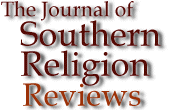
Susan Friend Harding,
The Book of Jerry Falwell: Fundamentalist Language and
Politics, Princeton, NJ: Princeton University Press,
2000. 336 Pages.
Susan Friend Harding’s The Book of
Jerry Falwell: Fundamentalist Language and Politics landed on
my desk not long after Falwell’s comments on the September
11th terrorist attacks. Falwell said that God might be
allowing “the enemies of America to give us probably what we
deserve.” It seemed a good time to reexamine Falwell’s
language and politics.
|
|
| "In a
Postscript, Harding takes aim at the common misconception
that the 'biblical realism' of born-again Christianity is
a rigid relic of premodernity. " |
|
|
|
The Book of Jerry
Falwell, writes Harding, “is a study of the language by
which many fundamentalist Protestants and their allies
transformed themselves during the 1980s from a marginal,
antiworldly, separatist people into a visible and vocal public
force.”(ix) She concentrates on Falwell’s role in
forging this transforming rhetoric which not only reconstituted
the various kinds of conservative Protestants as “born-again
Christianity” but also, she claims, changed “the rules
of national public discourse, and the meaning of modernity.”
(ix)
The book is divided into
two parts. In the first, “Rites of Origin,” Harding
provides fascinating discussions of the language of
fundamentalist witnessing and of the pivotal role of the Scopes
Trial in fashioning the “regime of secular modernity”
(75) in which “the public arena was off-limits to openly
Bible-believing voices.” (78)
“Rites of
Revision,” the second part, is Harding’s extended
examination of the particular rhetorics Falwell forged as part of
the larger project of contesting and overturning the cultural
verdict of Scopes and to place himself at the center of that
enterprise. These include Falwell’s portrayal of himself as
a “postbiblical character,” (27) the rhetoric of
fund-raising, the concepts of gender roles and family, abortion,
creationism, the reconciliation of political activism and
premillennialism, and the “telescandals” of the late
1980s. (A surprising omission is any sustained discussion of
Falwell’s rhetoric regarding homosexuality.)
In a Postscript, Harding
takes aim at the common misconception that the “biblical
realism” of born-again Christianity is a rigid relic of
premodernity. “In short,” she writes, “what we are
looking at is a kind of ‘flexible absolutism,’ or, more
precisely, a rhetorical capacity and will to frame new and
internally diverse cultural positions as ‘eternal
absolutes.’” (275)
There is much to
appreciate and to admire in Harding work. She grasps the complex
and fully human reality of the people who respond to
Falwell’s rhetoric. Harding does not construct
fundamentalists as a “problem” to be explained or to be
solved. The implicit “know your enemy” agenda of much
scholarship about political fundamentalism is absent. Even more
impressive is that Harding manages to do this with only an
occasional descent into tangles of post-structuralist jargon. Her
writing is usually clear and lively, and is not only accessible
to scholars in other fields but to a more general audience.
Harding’s focus on
fundamentalist language may prove frustrating to readers who
place as much importance on context as upon texts. Falwell’s
rhetoric was important but events and practical realities need to
be given equal weight. For readers less familiar with the
historical setting of Falwell’s career, such as
undergraduates, William Martin’s With God on Our Side
provides a useful complement.
Methodologically,
Harding positions herself, and invites her readers to do the
same, “in the gap between conscious belief and willful
unbelief.” She calls this stance “narrative
belief,” and claims it “opens up born-again
language.” (xii) There is much that Harding’s approach
does open up, but I think we need to recognize its limits. How
fully can we “learn how to hear Jerry Falwell as his people
do” (xii) unless we pass over into belief and take on the
real consequences of commitment? Harding’s gap between
belief and unbelief may be distinct from unbelief, but it is also
distinct from belief.
My greatest frustration
was Harding’s decision to end her study with the late 1980s.
The evolution of Falwell’s rhetoric on various topics since
then would have been worth at least one chapter. The “Tinky
Winky” controversy of 1999 occurred as the book was going to
press, but Falwell’s decision to affiliate with the Southern
Baptist Convention in 1996 and the anti-Clinton videos Falwell
distributed in 1994 are cited only in passing. Falwell’s
1997 autobiography goes unmentioned. A fuller discussion of these
and other developments since 1988 would have been helpful.
Even with these
limitations, The Book of Jerry Falwell, is an admirable
accomplishment and a significant contribution to the study of one
of the most important figures and movements in American
evangelicalism.
Justin Watson, Lafayette
College
© 2001 by The
Journal of Southern Religion. All rights reserved. ISSN
1094-5234






